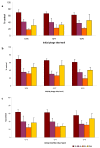Bacteriophages with the ability to degrade uropathogenic Escherichia coli biofilms - PubMed (original) (raw)
Bacteriophages with the ability to degrade uropathogenic Escherichia coli biofilms
Andrew Chibeu et al. Viruses. 2012 Apr.
Abstract
Escherichia coli-associated urinary tract infections (UTIs) are among the most common bacterial infections in humans. UTIs are usually managed with antibiotic therapy, but over the years, antibiotic-resistant strains of uropathogenic E. coli (UPEC) have emerged. The formation of biofilms further complicates the treatment of these infections by making them resistant to killing by the host immune system as well as by antibiotics. This has encouraged research into therapy using bacteriophages (phages) as a supplement or substitute for antibiotics. In this study we characterized 253 UPEC in terms of their biofilm-forming capabilities, serotype, and antimicrobial resistance. Three phages were then isolated (vB_EcoP_ACG-C91, vB_EcoM_ACG-C40 and vB_EcoS_ACG-M12) which were able to lyse 80.5% of a subset (42) of the UPEC strains able to form biofilms. Correlation was established between phage sensitivity and specific serotypes of the UPEC strains. The phages' genome sequences were determined and resulted in classification of vB_EcoP_ACG-C91 as a SP6likevirus, vB_EcoM_ACG-C40 as a T4likevirus and vB_EcoS_ACG-M12 as T1likevirus. We assessed the ability of the three phages to eradicate the established biofilm of one of the UPEC strains used in the study. All phages significantly reduced the biofilm within 2-12 h of incubation.
Keywords: UPEC; bacteriophage; biofilms.
Figures
Figure 1
Urinary tract infection (UTI) E. coli isolates positive for biofilm formation on 96-well microtiter plates. Isolates were considered as biofilm formers if the OD600 for the crystal violet-stained biofilm was equal to or greater than 3-fold the OD600 for a bacteria free medium. Data points represent an average of three independent experiments, each with 6 replicate wells for each isolate tested. Isolate CTF073 is a positive control for biofilm formation. Error bars indicate standard error of means.
Figure 2
Negative staining of phages ACG-C91 (a); ACG-M12 (b) and ACG-C40 (c) with 2% uranyl acetate or 2% phosphotungstate. Final magnification is × 297,000. Bars indicate 100 nm.
Figure 3
Phage disruption of established E. coli strain Can 91 biofilm. Biofilms grown in polystyrene microtiter plate wells for 48 h, were initially inoculated with 105, 107 and 109 pfu of phages (a) ACG-C40 and (b) ACG-C91 (c) ACG-M12. After 2, 4, 8 and 24 h of phage treatment at 37°C, average biofilm biomass in corresponding microtiter plate wells, were scored relatively to untreated control samples (100%) and represented on the Y-axes. Three independent experiments were performed, each starting from a different overnight culture and each with six repeats for each parameter combination. Error bars indicate standard error of means.
Similar articles
- Bacteriophage therapy for inhibition of multi drug-resistant uropathogenic bacteria: a narrative review.
Chegini Z, Khoshbayan A, Vesal S, Moradabadi A, Hashemi A, Shariati A. Chegini Z, et al. Ann Clin Microbiol Antimicrob. 2021 Apr 26;20(1):30. doi: 10.1186/s12941-021-00433-y. Ann Clin Microbiol Antimicrob. 2021. PMID: 33902597 Free PMC article. Review. - Identification of novel bacteriophage vB_EcoP-EG1 with lytic activity against planktonic and biofilm forms of uropathogenic Escherichia coli.
Gu Y, Xu Y, Xu J, Yu X, Huang X, Liu G, Liu X. Gu Y, et al. Appl Microbiol Biotechnol. 2019 Jan;103(1):315-326. doi: 10.1007/s00253-018-9471-x. Epub 2018 Nov 5. Appl Microbiol Biotechnol. 2019. PMID: 30397766 - Isolation and characterization of bacteriophages against E.coli urinary tract infection and evaluating their anti-biofilm activity and antibiotic synergy.
Devi B A, K V L, Sugumar S. Devi B A, et al. Microb Pathog. 2024 Aug;193:106789. doi: 10.1016/j.micpath.2024.106789. Epub 2024 Jul 6. Microb Pathog. 2024. PMID: 38972365 - |Isolation and characterization of novel bacteriophages as a potential therapeutic option for Escherichia coli urinary tract infections.
González-Villalobos E, Ribas-Aparicio RM, Montealegre GER, Belmont-Monroy L, Ortega-García Y, Aparicio-Ozores G, Balcázar JL, Eslava-Campos CA, Hernández-Chiñas U, Molina-López J. González-Villalobos E, et al. Appl Microbiol Biotechnol. 2021 Jul;105(13):5617-5629. doi: 10.1007/s00253-021-11432-6. Epub 2021 Jul 12. Appl Microbiol Biotechnol. 2021. PMID: 34254156 Free PMC article. - Antibiotic Resistance Among Uropathogenic Escherichia coli.
Kot B. Kot B. Pol J Microbiol. 2019 Dec;68(4):403-415. doi: 10.33073/pjm-2019-048. Epub 2019 Dec 5. Pol J Microbiol. 2019. PMID: 31880885 Free PMC article. Review.
Cited by
- Bacteriophage therapy for inhibition of multi drug-resistant uropathogenic bacteria: a narrative review.
Chegini Z, Khoshbayan A, Vesal S, Moradabadi A, Hashemi A, Shariati A. Chegini Z, et al. Ann Clin Microbiol Antimicrob. 2021 Apr 26;20(1):30. doi: 10.1186/s12941-021-00433-y. Ann Clin Microbiol Antimicrob. 2021. PMID: 33902597 Free PMC article. Review. - The Potential Role of Urinary Microbiome in Benign Prostate Hyperplasia/Lower Urinary Tract Symptoms.
Yu SH, Jung SI. Yu SH, et al. Diagnostics (Basel). 2022 Aug 1;12(8):1862. doi: 10.3390/diagnostics12081862. Diagnostics (Basel). 2022. PMID: 36010213 Free PMC article. Review. - Management of urinary tract infections in patients with neurogenic bladder: challenges and solutions.
Pannek J, Wöllner J. Pannek J, et al. Res Rep Urol. 2017 Jul 11;9:121-127. doi: 10.2147/RRU.S113610. eCollection 2017. Res Rep Urol. 2017. PMID: 28761863 Free PMC article. Review. - Escherichia coli as a Multifaceted Pathogenic and Versatile Bacterium.
Braz VS, Melchior K, Moreira CG. Braz VS, et al. Front Cell Infect Microbiol. 2020 Dec 21;10:548492. doi: 10.3389/fcimb.2020.548492. eCollection 2020. Front Cell Infect Microbiol. 2020. PMID: 33409157 Free PMC article. Review. - Isolation and Characterization of Lytic Bacteriophages Active against Clinical Strains of E. coli and Development of a Phage Antimicrobial Cocktail.
Alexyuk P, Bogoyavlenskiy A, Alexyuk M, Akanova K, Moldakhanov Y, Berezin V. Alexyuk P, et al. Viruses. 2022 Oct 28;14(11):2381. doi: 10.3390/v14112381. Viruses. 2022. PMID: 36366479 Free PMC article.
References
- Sanford J.P. Urinary tract symptoms and infections. Ann. Rev. Med. 1975;25:485. - PubMed
- Nicolle L.E., Ronald A.R. Recurrent urinary tract infection in adult women: Diagnosis and treatment. Infect. Dis. Clin. N. Am. 1987;1:793–806. - PubMed
- Nicolle L.E. Epidemiology of urinary tract infections. Clin. Microbiol. Newslett. 2002;24:135–140.
- Czaja C.A., Hooton T.M. Update on acute uncomplicated urinary tract infection in women. Postgrad. Med. 2006;119:39–45. - PubMed
Publication types
MeSH terms
Substances
LinkOut - more resources
Full Text Sources
Other Literature Sources


